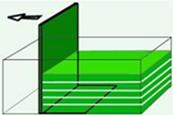Deformation experiments
These experiments all follow from the web pages on Metamorphism & Deformation.
Regional metamorphism is not easily modelled in the lab, but the deformation of rocks that normally accompanies it can be modelled very successfully. It is a good idea to stress that, when applied to rocks, these processes happen very slowly – often over thousands or millions of years.
Three experiments are given as worksheets; we suggest choosing one. Here are a few further tips:
Regional metamorphism is not easily modelled in the lab, but the deformation of rocks that normally accompanies it can be modelled very successfully. It is a good idea to stress that, when applied to rocks, these processes happen very slowly – often over thousands or millions of years.
Three experiments are given as worksheets; we suggest choosing one. Here are a few further tips:
1. Folds & Faults using sand & flour: See also: “Teaching the Dynamic Earth” (ESEU Website)
The animation (below) shows typical results from this experiment which, although a bit tricky to set up, shows folding and faulting very well. Suitable boxes are plastic storage drawers typically used for screws nails, etc. (or Ferrero Rocher boxes), whilst “paddles” are easily made from hardboard or plywood. An interesting variant (practice needed) is to attach a piece of card to the bottom of the paddle, about 1/3rd the length of the box and, with the paddle 1/3rd of the way along the box, fill the larger portion (with the end of the card in the middle) with sand/flour layers about 2/3rds full. Move the “paddle” backward (arrow) to make a “rift valley”.
An interesting variant (practice needed) is to attach a piece of card to the bottom of the paddle, about 1/3rd the length of the box and, with the paddle 1/3rd of the way along the box, fill the larger portion (with the end of the card in the middle) with sand/flour layers about 2/3rds full. Move the “paddle” backward (arrow) to make a “rift valley”. 
